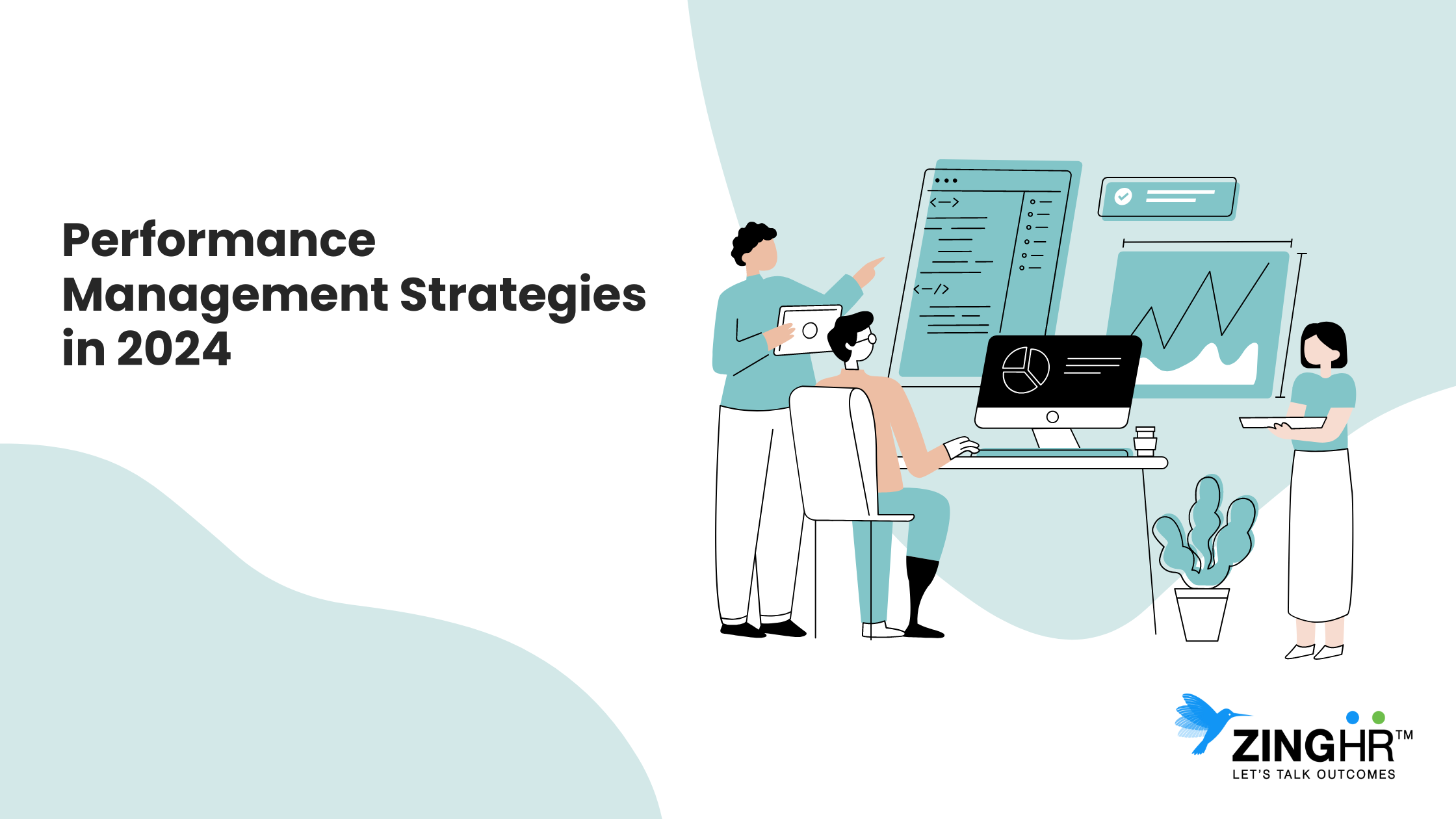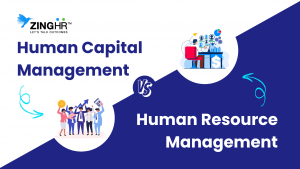Performance management is not a one-time process, it is a continuous process of setting goals, training, mentoring, reviewing, and providing feedback to ensure that employees are meeting their objectives with organizational goals. Both employers and employees should have the same goals and drive in the same direction of success.
According to a study by Gallup, Organizations implement effective performance management practices to see a 15% percent reduction in turnover and a 21% percent increase in profitability.
Moreover, a report by Deloitte indicates that 90% of HR leaders believe performance management processes need to be redesigned. And increased focus on real-time feedback. Organizations that restructured and more agile processes have experienced a 30% increase in employee engagement.
Performance management is not just a tool for improving employee productivity, it is crucial for reducing the attrition rate, aligning goals for business outcomes and fostering a culture of growth.
In this blog post, we will explore performance management Strategies and provide tips for achieving success using them.
13 Successful Performance Management Strategies
- Addressing Performance
- Understanding SMART
- Recognizing and Rewarding Achievement
- Surveys to Understand Your Employee Emotions
- Conduct One-on-one meetings
- Transparency
- Consistency
- Employee Well-being
- Performance reviews
- Embracing Technology for Better Insights
- Performance Goals
- Continuous Learning & Development
- Personal Development
What is the Performance Management?
Performance management is an ongoing activity that requires constant communication between an employer and an employee. The purpose is to establish clear goals, evaluate work performance, and encourage development. Essentially, it is the process of recognising, measuring, and improving an employee’s performance. According to studies, 85% of employees who have frequent weekly meetings with their managers report better levels of engagement. However, Despite its importance, performance management is frequently difficult to implement successfully.
The following sections describe 13 excellent performance management strategies that can help companies improve their performance and achieve their objectives.
13 Performance Management Strategies 2025
Addressing Performance
Addressing performance difficulties is an important part of good performance management. When an employee’s performance falls short of expectations, the problem must be handled with sensitivity and transparency. Managers should have positive interactions aimed at finding the fundamental causes of the performance discrepancy.
Providing precise comments, setting clear expectations for development, and offering assistance or resources to help the employee succeed are all important aspects. The goal is to create a pleasant environment in which employees feel encouraged rather than penalized, as resulting in improved performance and morale.
Understanding SMART
Setting SMART goals is a strategic approach to goal-setting that ensures clarity and focus in achieving objectives. SMART stands for Specific, Measurable, Achievable, Relevant, and Time-bound. This framework helps individuals and teams create clear and actionable goals. By being specific, goals are well-defined and leave no room for ambiguity. Measurable goals allow progress to be tracked and success to be quantified. Achievable goals are realistic and attainable, considering available resources.
Here is a Breakdown of the SMART Goals:
#Specific
Goals should be clear and comprehensive, with no ambiguity. Define what has to be done and why it is necessary. Instead of stating a generic aim like “improve sales,” specify “increase product X sales by 20% in the next quarter.”
#Measurable
Make sure the goal includes quantifiable or assessable criteria so you can measure progress and know when it has been achieved. For example, “increase website traffic by 15% over the next two months” sets a quantifiable goal.
#Achievable
Given the resources, time, and skills available, goals should be realistic and achievable. To minimize dissatisfaction, goals should be hard but yet achievable. Setting a goal to “complete a major project in one month with a small team” may be attainable if the team have the requisite skills and resources.
#Relevant
Goals must be consistent with wider business objectives and contribute to the organization’s performance. They should contribute to long-term strategies and the broader mission. For example, a goal to “launch a new marketing campaign that targets a key demographic” is relevant if it aligns with the company’s growth plan.
#Time-Bound
All objectives ought to have a completion date or period. This makes things seem more urgent and aids in work prioritization. A goal such as “Reduce customer support response time to under 5 minutes within the next two months” clearly states when it must be accomplished.
Recognizing and Rewarding Achievement
Maintaining high levels of employee engagement and motivation requires rewards and recognition. When employees feel that their efforts are valued and appreciated, they are more likely to stay committed to their work and strive for excellence.
There are various ways to show appreciation, from formal awards and incentives to small tokens of gratitude like a thank-you card or a public acknowledgement during a meeting. In addition to raising spirits, genuine and consistent praise also promotes good conduct and motivates others to provide their best efforts.
Surveys to Understand Your Employee Emotions
Conducting surveys to understand employee emotions is a powerful tool for gauging the overall sentiment within an organization. These surveys indicate how employees feel about their jobs, leadership, and workplace culture. Companies gather and analyze feedback regularly to identify areas of concern, address potential issues before they develop, and foster a more supportive and inclusive workplace. Furthermore, understanding employee emotions through surveys enables informed decisions that improve work happiness and retention.
Conduct One-on-One Meetings
One-on-one meeting usually happens between managers and employees and it is essential for effective performance management. These conversations foster open and honest dialogue, allowing managers to deliver tailored feedback, discuss career development, and handle any employee issues.
Regular 1:1 meetings assist in establishing trust and boosting relationships, So, employees feel supported and valued. They also enable managers to ensure that individual goals align with the company’s overall objectives, which leads to a more engaged and motivated workforce.
Transparency
Transparency in the workplace is essential for building trust and fostering a positive work environment. When leaders are open about the organization’s goals, challenges, and decisions, employees are more likely to feel included and committed to the company’s success. Transparency also encourages honest communication, where employees feel safe to share their thoughts and concerns. Being transparent, organizations can create a culture of accountability and collaboration, and lead to better decision-making and stronger team dynamics.
Consistency
Maintaining consistency in performance management is critical for preserving fairness, developing confidence, and ensuring employees understand the objectives. When performance management strategies are consistent, all employees are assessed using the same criteria, reducing the risk of bias and creating a feeling of equality throughout the company. This consistency helps employees understand what is expected of them and what they may anticipate in return, which is critical for retaining motivation and engagement.
How to Maintain Consistency:
Here are the 7 tips for Maintaining consistency in your workplace
#Learn How to Prioritize
Prioritization is critical for keeping consistency in performance management. Employees and managers who understand how to prioritize can focus on the most important activities and goals that drive company achievement.
#Limit Distractions
Limiting distractions is critical for maintaining focus and consistent performance. In today’s fast-paced workplace, distractions can quickly derail productivity and result in inconsistent performance.
#Establish Clear Guidelines
Develop and communicate standard procedures for performance management that apply to individual employees.
#Regular Training
Provide ongoing training for managers to ensure they are applying performance management practices consistently.
#Use Tools and Systems
Implement workforce management software to standardize tracking, feedback, and evaluation processes.
#Monitor and Review
Regularly assess the consistency of performance management practices and make adjustments as needed.
#Foster Open Communication
Encourage feedback from employees to identify any inconsistencies and address them promptly.
Employee Well-being
‘Mental Health’ is the new buzzword on the block. With remote work becoming the new normal, opportunities for human engagement in traditional office spaces have been mitigated to a large extent. Under the circumstances, maintaining employee well-being and engagement is paramount. A happy, content employee is the key to better performance outcomes. Work-life balance, work environments with positive vibes, creative engagement, and mentor programs are some of the initiatives that have surfaced to help cultivate a motivated workforce, thereby leading to enhanced productivity.
Performance Reviews v/s Feedback Mechanisms
Evaluating employees based on a once-a-year performance review is fast being replaced by Feedback mechanisms. A structured exchange of valuable insights between employees and managers helps the former express their opinions and concerns in a fearless environment. These real-time feedback sessions conducted transparently, point the management’s attention to areas of improvement. Besides immediate course corrections, these also help foster a sense of ‘being valued’ in the employees. Moving from mere ‘Measuring Performance’ to ‘Ensuring Performance’, in addition to Continuous Feedback, is the way forward to increase employee retention.
Embracing Technology for Better Insights
Organizations are adopting artificial intelligence and people analytics as the newest tools to manage performance. Gaining an in-depth understanding of employee performance trends, skill improvement areas, and growth potential scopes have now become significant parameters. Data-driven insights from sophisticated analytics tools are the way forward for most businesses. By embracing the latest technological trends, organizations can make more prudent decisions vis-a-vis succession planning and talent development.
Performance Goals – no More Rigidity
In a fast-evolving scenario, even goal-setting approaches are becoming more flexible. Market dynamics and business needs are shifting swiftly, leading to shifts in priorities too, thus affecting performance goals. It is therefore advisable to encourage employees to set dynamic goals that evolve over time. By doing so, a culture of agility and resilience is fostered within the organisation, helping employees to quickly craft altered goals when circumstances change.
ZingHR’s web-based Performance Management & Appraisal System helps ease planning, monitoring, and evaluating your employees’ performance. With this popular HR software, establish parameters, encourage better productivity, and help employees achieve the highest satisfaction at work.
Continuous Learning & Development
Empowering employees not only leads to better bottom lines in annual reports but also instils in employees a sense of loyalty, thus enhancing retention levels. In a dynamic world, skills are fast becoming obsolete. Prioritizing employee skill development as part of an ongoing L&D program is fast gaining significance in an organization’s performance management strategy. This involves providing employees with access to training programs, mentorship opportunities, and personalized learning resources tailored to their individual career aspirations.
The most effective cloud-based learning management system is Zing Learn. Design, deliver and track online courses. Devise interactive and gamified courses for your employees, driven by your organization’s objectives. Enjoy complete control over the training course setup, tests and analytics. Get the desired outcomes today.
The performance management terrain is evolving quickly in 2025. Technological advancements, shifting workplace dynamics, and a renewed focus on employee well-being and development are the factors to watch out for. By embracing continuous feedback, leveraging technology, prioritizing employee engagement, fostering a culture of learning, and embracing flexibility in goal setting, organizations can hope to become industry leaders in the near future.
Personal Development
Personal growth like learning a new skill or upgrading an existing one, is an important factor for employee happiness and long-term job success.
Organizations that invest in their employees’ growth and allow them to achieve their greatest potential, lead to increased job satisfaction and performance.
This can be accomplished through various methods including training programs, workshops, mentorship, and allowing personnel to take on new tasks and responsibilities. An emphasis on personal development not only improves individual capacities but also helps the business expand and compete more effectively.
Traditional vs. Modern Performance Management: A Paradigm Shift
Performance management has significantly evolved over the past decades. Traditional PM primarily focuses on annual reviews, where employee are evaluated based on their past performance against static goals. In traditional PM, feedback was generally provided in a formal, top-down approach, with the limited real-time collaboration between managers and employees. In contrast, modern PM provides ongoing feedback, training, and development opportunities for dynamic goal setting.
Traditional vs. Modern Performance Management Table
| Aspect | Traditional PM | Modern PM |
|---|---|---|
| Frequency of Evaluation | Annual or bi-annual performance reviews | Continuous feedback and regular check-ins |
| Focus | Past performance and evaluating against fixed goals | Future-focused, real-time goal alignment and employee development |
| Manager-Employee Interaction | Limited to scheduled reviews | Ongoing interactions and coaching, learing, training |
| Feedback Style | Top-down, formal evaluation | 360-degree feedback from multiple sources (peers, colleague, etc.) |
| Goal Setting | Static, set at the beginning of the year | Dynamic, priority wise, flexible goals that adapt to changing business needs |
| Technology Use | Primarily paper-based or basic software | Advanced performance management systems with real-time data tracking |
| Motivation Approach | Performance-based rewards at the end of the year | Continuous recognition, rewards, and real-time adjustments |
| Transparency | Limited visibility into performance metrics | High transparency with clear, data-driven insights available to employees |
How do you Manage Employee Performance Using HRMS?
1. Set Up KPIs, OKRs, Goals, and Tasks
HRMS (Human Resource Management Systems) allows businesses to successfully establish and manage Key Performance Indicators (KPIs), Objectives and Key Results (OKRs), objectives, and tasks.
Employees may see what is expected of them by creating clear metrics and objectives inside the HRMS. This alignment guarantees that individual efforts are closely related to company goals. The HRMS facilitates the recording and modification of key parameters, allowing employees and management to evaluate progress and make data-driven choices.
2. Performance Improvement Plans
When an employee’s performance falls short of expectations, HRMS is an effective tool for implementing and tracking Performance Improvement Plans (PIPs). These strategies target specific performance gaps and aim to help individuals develop their abilities to meet corporate requirements.
Managers may use the HRMS to create clear targets, offer resources, and track the development of PIPs, ensuring employees have the necessary assistance to succeed.
3. Performance Tracking Progress
Tracking Employee performance allows employees to understand areas for improvement. It provides a clear vision to the managers and employees to monitor progress in real-time. You can automate tracking with the HRMS which provides a centralized dashboard that displays key metrics, milestones, and achievements. This ongoing tracking not only boosts individual productivity but also contributes to overall organizational success by aligning efforts with objectives.
4. Employee Retention
Employee Retention technique is an organization’s ability to retain employees and reduce attrition rate. It is every organization’s objective and it can directly impact an organization’s success and sustainability.
HRMS systems aid retention efforts by offering a systematic approach to performance management in which accomplishments are recognized and development opportunities are clearly defined. Organizations may increase employee happiness and minimize turnover by utilizing HRMS to track career progression, acknowledge accomplishments, and provide individualized development plans.
5. 360 Feedback
360-degree Feedback is a method of collecting feedback regarding employee performance from many sources, such as managers, peer-to-peer, colleagues, managers, co-workers, etc. In HR Software, 360 Feedback is integrated with the performance management module so it is easier to collect, analyze, and act on feedback. This process helps to identify strengths as well as weaknesses for improvement from multiple perspectives. You can identify skill gaps and address them through training and development.
6. Fair Performance Evaluations
Unbiased performance evaluations are very important for maintaining motivation and trust within the workforce at the same time with employees. HR Software ensures that the evaluation process depends on feedback, reports, and analytics based on these criteria.
Conclusion
Which is the Best Performance Management Software?
Performance management software is a crucial tool for modern organizations and it is designed to streamline the process of evaluating, improving and tracking performance. ZingHR Enable managers to set clear goals, monitor progress and provide continuous feedback within a centralized platform. When you need to create performance management strategies, Zing is a great option to enhance employee performance and drive business success. The ZingHR PMS module is desig to help organizations drive employee engagement and productivity.




